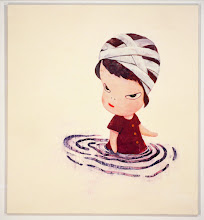I've been scavenging lately through Indian biologist Sunil Kumar (S. K.) Pal's decade-plus research on free-ranging dogs in Katwa, West Bengal (you'll need institutional subscription to access most of these titles, sorry...) The statistics in these articles frankly hurt my poor little humanist brain a bit - nevertheless I'm learning lots about filiative and affiliative behavior among these hard-scrabble creatures. Maybe I'm delusional, but behind the ='s and %'s I think there's a certain stark poetry in narrative passages like this:
Of all pups (N = 35), only 13 survived to the age of 3 months showing 63% pup mortality. Of all pup deaths (N = 22) recorded in the study, 2 (9%) were due to adverse weather, 5 (23%) from various diseases, 4 (18%) from collisions with automobiles, 2 (9%) from predation by adult dogs, 3 (14%) from malnutrition (interviews with area residents), and 6 (27%) deaths were caused due to removal of pups as pets by the children particularly of the lower-class section.
Charles Darwin thought that domesticated species in non-Western, non-industrialized societies were more likely to have to fend for themselves, find their own food in the lean seasons, etc. As such, they were subject to greater pressures of natural selection than their European counterparts, who were shaped primarily by human-orchestrated artificial selection, by "man's wants and fancies." I'm struck by how "natural" and "artificial" dangers commingle in Pal's account of pup death - how dog life is imperiled by human technology (automobiles) and human desire (pet-seeking children) alike.- "Parental care in free-ranging dogs, Canis familiaris,"
Applied Animal Behaviour Science 90 (2005)
* image from Are you a Pariah Dog fan?








No comments:
Post a Comment